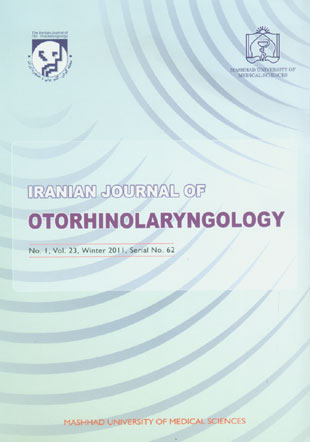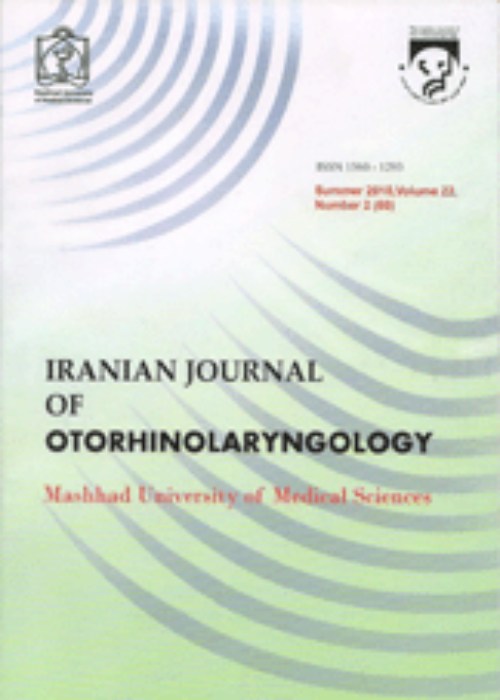فهرست مطالب

Iranian Journal of Otorhinolaryngology
Volume:23 Issue: 1, Jan-Feb 2011
- تاریخ انتشار: 1389/12/25
- تعداد عناوین: 8
-
-
Page 1Acoustic neuromas (AN) are schwann cell-derived tumors that commonly arise from the vestibular portion of the eighth cranial nerve also known as vestibular schwannoma(VS) causes unilateral hearing loss, tinnitus, vertigo and unsteadiness. In many cases, the tumor size may remain unchanged for many years following diagnosis, which is typically made by MRI. In the majority of cases the tumor is small, leaving the clinician and patient with the options of either serial scanning or active treatment by gamma knife radiosurgery (GKR) or microneurosurgery. Despite the vast number of published treatment reports, comparative studies are few. The predominant clinical endpoints of AN treatment include tumor control, facial nerve function and hearing preservation. Less focus has been put on symptom relief and health-related quality of life (QOL). It is uncertain if treating a small tumor leaves the patient with a better chance of obtaining relief from future hearing loss, vertigo or tinnitus than by observing it without treatment. In this paper we review the literature for the natural course, the treatment alternatives and the results of AN. Finally, we present our experience with a management strategy applied for more than 30 years.
-
Page 11IntroductionThe pericranial flaps'' benefits have been described in many otolaryngologic, maxillofacial and plastic surgery literature. The benefits ar e due to the pericranial flaps unique characteristics including good flexibility and mobility, very rich blood supply from several arterial sources and access to sufficient bulk of the flap without any need for distant surgical sites. Using pericranial flaps to repair the local defects of the head and face region in several cases has been reported in this study.Materials And MethodsA follow up study was carried out on 12 patients who had undergone frontal sinus obliteration; auriculoplasty and repair of the orbital walls and scalp’s defects. Pericranial flap had been used for all these patients. Demographic specifications, surgical indications, imaging evaluations and early and late complications were recorded as well. The functional and cosmetic results and also the satisfaction level of patients were also assessed.ResultsAccording to the average follow up period which lasted about 4 years, none of the patients suffered early or late significant complications. No disease relapse or need for revision surgery was reported. Almost all patients were completely satisfied with the procedure and its cosmetic results.ConclusionThe use of a pericranial flap is a simple, quick, cost-effective and safe method for repair of head and face defects. Although, a longer follow up time is required, but this uncomplicated method has been considered as an ideal method to repair sinonasal, ear and scalp defects.
-
Page 23IntroductionSinusitis is one of the most common diseases in general and in otolaryngology practice, but the optimal therapeutic options have not yet been fully developed. This manuscript will try to compare normal saline nasal douching with hypertonic saline in reducing symptoms and improving its signs.Materials And MethodsOne hundred and fourteen patients suffering from non acute rhinosinusitis, documented by history, physical examination and radiologic studies were divided into normal saline and hypertonic saline groups, each consisting of 57 patients. data were obtained by physical examination and a questionnaire..ResultsType of treatment had no significant effect on headache, morning dryness of mouth and pharynx and fatigue. Nontheless, nasal congestion, purulent discharge and postnasal discharge were reported to have improved in the group treated with hypertonic saline versus the normal saline group. Patient satisfaction also showed better scores in the hypertonic saline group.ConclusionHypertonic saline (3%) is more effective for nasal irrigation than normal saline in chronic rhinosinusitis.
-
Page 29IntroductionIL-8 is one of the pro-inflammatory cytokines which can play an essential role in the pathogenesis of chronic rhinosinusitis (CRS) as well as nasal polyposis (NP). The ability of individuals in producing IL-8 is partially determined by IL-8-251 A/T polymorphism. Hence, the aim of the present study was to investigate the association between IL-8-251 A/T and CXCR2 +1208 C/T genes polymorphisms and susceptibility to CRS and NP.Materials And MethodsTwo hundred and forty fiveCRS patients and 204 healthy controls were included in this study. CRS patients were categorized by the existence or absence of NP. IL-8 promoter-251 A/T and CXCR2 +1208 C/T gene polymorphisms were genotyped via the allele specific PCR (AS-PCR) method.ResultsWhile no remarkable difference was demonstrated between patients and controls for both CXCR2 +1208 C/T and IL-8 -251 A/T polymorphisms, a significant increase in IL-8-251 AA genotype was detected in CRS patients with NP compared to those without it (29.3% and 16.2%, respectively; P=0.03). Interestingly, this association got far stronger when only non-asthmatic CRS patients were taken into consideration (P=0.001).ConclusionThe results of the present study indicate that the inheritance of IL-8-251 Aallele is associated significantly with NP development in CRS patients. Therefore, NP formation might be a result of the exposure to an intense inflammatory environment, which is more likely in genetically susceptible CRS patients.
-
Page 37IntroductionTo identify changes in OAEs parameters in treatment course of idiopathic sudden sensorineural hearing loss (iSSNHL).Materials And MethodsIn aprospective studyfromAugust 2005 to January 2009, 26 patients with iSSNHL underwent conventional audiometry/tympanometry and two types of OAEs (TEOAEs and DPOAEs) before and after the completion of standard drug therapy.The changes in pre- and post- treatment parameters were compared with each other and with normal-contralateral ears.ResultsIn TEOAEs, the mean overall correlation (reproducibility) and the mean overall strength in involved ears were 10.96±23.36 and 0.99±3.45 dB, respectively, before the treatment, which reached 22.88±36.55 and 1.85±5.3, respectively, after the treatment (P>0.05). Significant difference between “correlation score” (average of correlations at 3-4 involved frequencies) before and after treatment was found: 6.52 ±18.19 vs. 21.67±37.8 (P<0.034). The difference between pre- and post-treatmentoverall correlation and correlation score in the “response group” were significant (P<0.031). In DPOAEs of the involved ears, the mean DP1 level and the DP1 signal-to-noiseratio changes were not significant with the treatment (P>0.05).ConclusionEvoked OAEs, especially TEOAEs, are objective, rapid, and sensitive tools in the treatment course of iSSNHL.
-
Page 45IntroductionSchawannomas (neuromas, neurilemmomas) are benign tumors originating from showann cells or nerve fiber sheet cells. They are solitary, encapsulated tumors usually attached to, or surrounded by a nerve.Case Report:We present a case of left hypoglossal nerve schwannoma in a 19 year old man who was admitted with progressive left tongue atrophy.ConclusionSchwannoma of the hypoglossal nerve usually develops in the intracranial and extracranial portion or both in the intracranial and extracranial components forming a dumbbell shape tumor. The peripheral hypoglossal schwannomas are extremely rare.
-
Page 51Ear candling is an alternative medicine practice alleged to enhance general health by putting an end of a hollow candle in the ear canal and lighting up the other end of it. It also is advertised for cerumen and debris (bacteria and fungi) removal.Ear candling is claimed to create negative pressure for drawing cerumen from the ear and to benefit the ears in many ways. It is however not free of complications and is now banned. Here we would like to highlight potential complications to this.
-
Page 55IntroductionVascular abnormalities are relatively uncommon lesions, but head and neck is a common region for vascular malformation which is classified as benign tumors. In this paper, the authors report a rare presentation of vascular malformation in the tongue and its managements.Case Report: An 18 months 2 old child presented with a giant mass of tongue which caused functional and aesthetic problem. The rapid growth pattern of cavernous hemangioma was refractory to corticosteroid. The lesion was excised without any complication. Since the mass was so huge that not only filled entire oral cavity but was protruding outside, airway management was a great challenge for anesthesia plan and at the same time surgical technique was difficult to select.ConclusionDespite different recommended modalities in managing hemangiomas of the tongue, in cases of huge malformations, surgery could be the mainstay treatment and provided that critical care measures are taken in to account, could be performed very safely.


